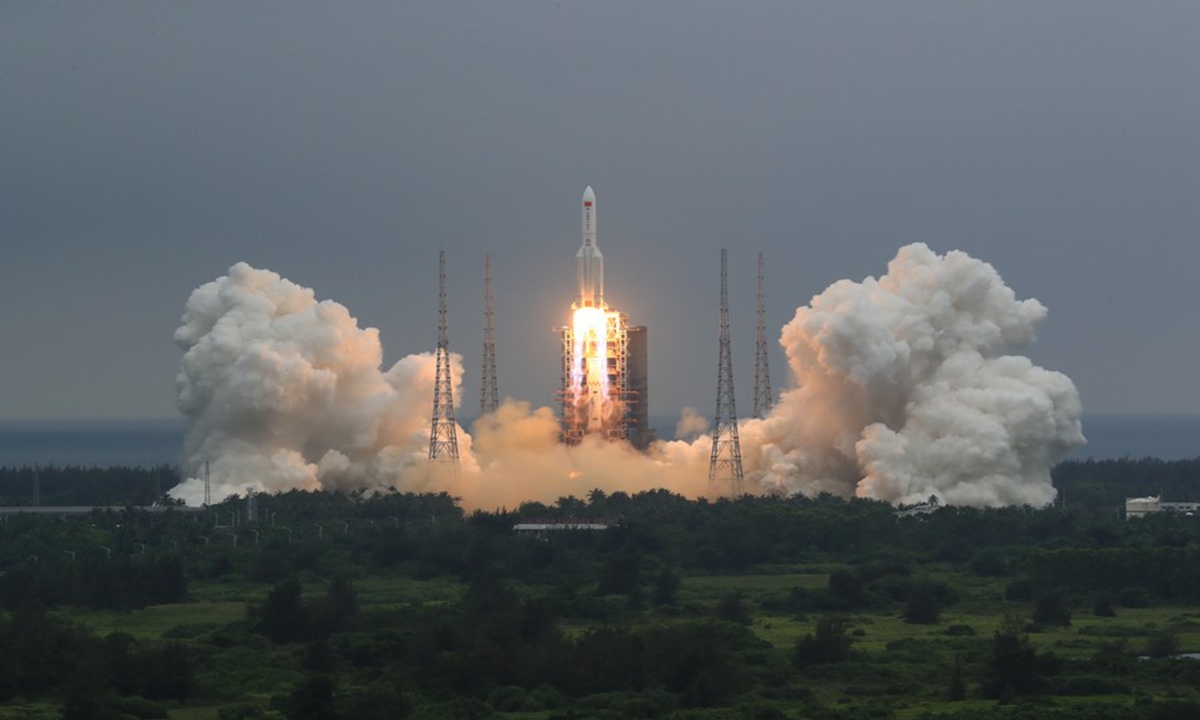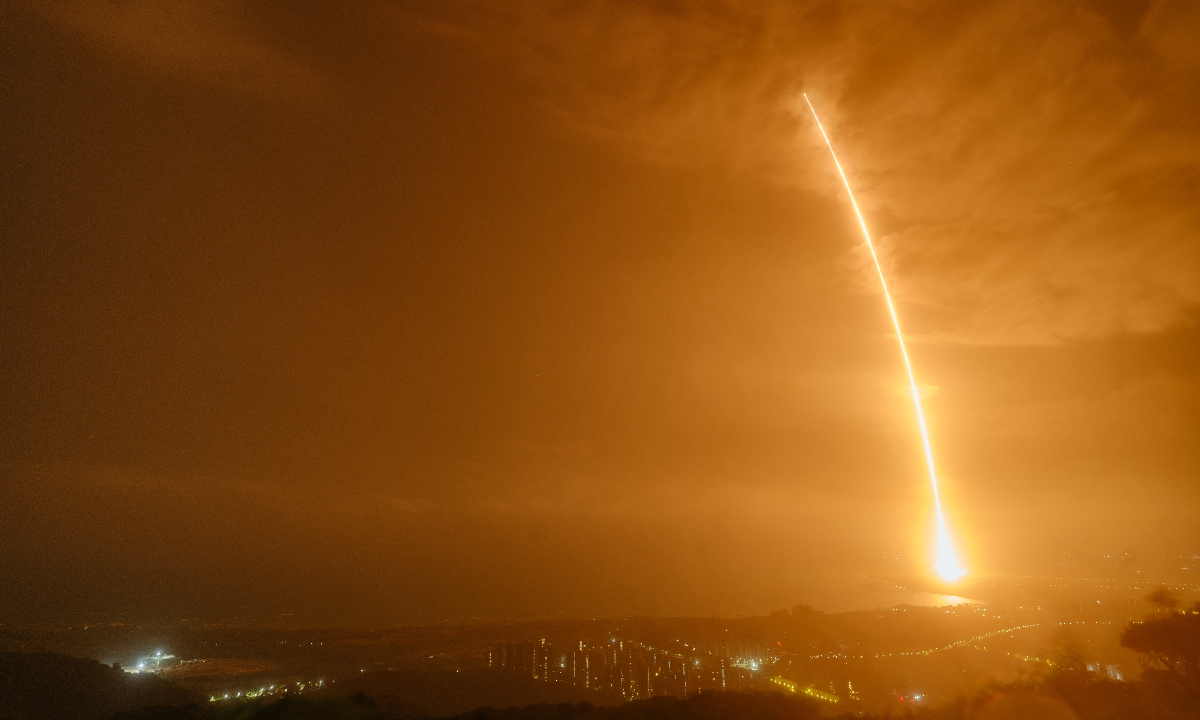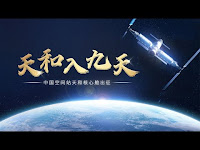China's Tianhe space station core cabin received its first "visiting guest" - the Tianzhou-2 cargo spacecraft early Sunday, about 8 hours after the latter's launch, setting a new record in China's space history.
According to the China Manned Space Agency, the rendezvous and docking of the Tianzhou [Heavenly Vessel] cargo spacecraft with the Tianhe core cabin took around eight hours after the former was launched from Wenchang spaceport from South China's Hainan Province via a Long March 7 carrier rocket at 8:55 pm Saturday.
The first spaceship launched in the space station construction phase, Tianzhou-2 weighed 13.5 tons at launch, and is capable of sending a payload of 6.9 tons for supply missions. Its in-orbit service is at least one year, said Feng Yong, commander-in-chief of the Tianzhou-2 mission from the project contractor China Academy of Space Technology (CAST).
The 10.6-meter-long, 3.35-meter-diameter Tianzhou-2 cargo spaceship has two components - a totally enclosed cargo cabin and a propelling cabin, according to CAST.
The carry-on onboard the Tianhe spacecraft includes consumables that are designed to support three astronauts on their space missions for three months, space suits for missions outside cabin and other supplies, Feng revealed, adding that during its docking with the space station core cabin, it will also carry out multiple in-orbit experiments.
Tianzhou-2 will also deliver propellants to refuel the Tianhe core cabin, Mu Guoxin, a CAST publicity official said.
"Next, the Shenzhou-12 manned spaceship will dock with the core cabin at the front, and altogether the three sections will form the first linear structure for China's space station," Mu noted.
There were 6.8 tons of supplies onboard the Tianzhou-2, including some 160 parcels of goods and two tons of propellants, according to CAST. "The load to total mass ratio is over 50 percent, indicating its world leading capacity."
The two space suits for the astronauts' outside-cabin activities weigh more than 100 kilograms each, it disclosed.
The Saturday mission also witnessed a substantial improvement in the Tianzhou spacecraft's fast docking capability. Compared to the Tianzhou-1's rendezvous and docking with Tiangong-2 in 2017, which took about two days, it took a mere eight hours to achieve the feat.
Lei Jianyu, deputy director designer of the Tianzhou-2 spacecraft, said that there are only two cargo spaceships in active service in the world that are capable of sending payloads of more than five tons, and Tianzhou is one of them, and has the "world class capability."
The reason behind such progress lies in the fact that all the information for the docking maneuver had been installed in software with the Tianzhou-2, saving the time needed to transfer such instructions from ground tracking and monitoring facilities, which was the case for Tianzhou-1 in executing the same move.
"Such a fast rendezvous and docking process not only shortens the stay of astronauts in the relatively narrow space in the spaceship, saving their energy, but also ensures that the transfer of fresh goods [such as biological agents] is conducted in a timely fashion," CAST developers said.
The Tianzhou-2 adopted a new long-distance guiding technology, as it was able to use the location information provided by the country's BeiDou Navigation Satellites System, or BDS, to automatically navigate itself for the rendezvous and docking with the space station, whereas the Tiangong-1 version needed artificial assistance to lead the craft to approach Tiangong-2 for the move.
In an ideal situation, the time for the rendezvous and docking of Tianzhou-2 would be reduced to some four hours, CAST announced.
In the event of an emergency, this kind of fast rendezvous and docking technology will also facilitate quick responses by providing all kinds of urgently needed materials to the space station and rescue the trapped astronauts, according to the academy.
Yang Sheng, the cargo spacecraft system's chief designer, disclosed that ground logistics technology has also been adopted for the spacecraft. For example, astronauts can obtain the location and further information of specific goods by scanning a QR code, and the inventory information is recorded in a dynamic manner so that astronauts can keep track of changes of goods.
China is continuously creating legends in space:

The Long March-5B Y2 rocket, carrying the Tianhe module, blasts off from the Wenchang Spacecraft Launch Site in south China's Hainan Province, April 29, 2021. Photo: Xinhua
China on Thursday successfully sent into space Tianhe core module of space station. This marks China's space station construction entering the full implementation stage. It's a crucial step forward for China's manned space program. Hundreds of millions of Chinese people felt inspired by the success.
Building a space station is to build a house in space. The core module is not only the command and control center of the space station, but also lays the foundation for the station. According to the China Manned Space Engineering Office, China will kick off intensive launch missions, including three modules, four cargo spacecraft and four manned spaceships. China is expected to finalize an orbital construction next year. After the "house" is built, our astronauts can move in and start various important space experiments.
It is worth noting that China's space station will operate for at least 10 years, and the International Space Station (ISS) is scheduled to come out of service in 2024. This means, at that time, China's space station would probably be the only one of its kind in space. Sending astronauts in space and building a space station are a dream comes true for Chinese people. When a Chinese astronaut looks at Earth from China's space station, it will represent not only the advancement of China's aerospace technology but also a great breakthrough of Chinese people's vision and imagination.
People know there are unlimited possibilities in outer space, but the threshold of space exploration is extremely high. Without the support of the strong comprehensive national strength and the top-level aerospace technology and research as well as manufacturing capabilities, what China has achieved would never be thinkable. We should be proud of our achievements in the aerospace cause under the West's doubt and isolation. The US once blocked China from participating in the ISS project, and thus pushed China to rapidly develop its own aerospace technology. Today, we are going to have our own space station. This will provide a profound lesson and inspiration to the Chinese people.
Chinese society has had a relatively full understanding of the significance of aerospace technology development. But every time China carries out a major space mission, some voices always emerge saying that as China still faces many difficulties in improving livelihoods, it shouldn't spend so much money on space projects that are hard to reap profits in the short term. This is narrow-minded and shortsighted. For a big country like China, it is destined to conquer space and sea. We cannot talk about China's rise if the country hasn't made breakthroughs in high-end areas such as the aerospace industry. China's livelihood development will also encounter obstacles. In the long run, when the aerospace technology progresses, it is bound to boost China's livelihood.
China's aerospace development started late from a low point, but has achieved outstanding progress in a short period of time. Through the efforts and contributions of several generations of people engaging in the aerospace cause, China has caught up with the world's aerospace powers. From the achievements of "two bombs and one satellite" to the status as an aerospace power, China has displayed Chinese people's national spirit of self-improvement and self-reliance. Without such national spirit, it's unimaginable that China could achieve such aerospace achievements. As long as the spirit exists, China will create a new legend.
Of course, compared with the US and Russia, China still lags behind. But the gap is also a driving force. China should enter space step by step. Mankind's exploration of outer space has just begun. There is infinite space waiting for human beings to explore. From this sense, the narrow-mindedness of Washington is clear as it is racking its brain to engage in geopolitical competition with China.




No comments:
Post a Comment